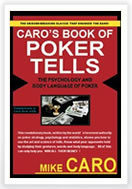 |
Author: Mike Caro Publisher: Cardoza Pages: 320 Pub. Date: 2003 Price: $16.47 |
Book Review: Part 1
Reading one’s opponent at the poker table is vital to live-game poker success, but a how-to guide remained unavailable until Mike Caro’s mid-‘80s publication of Caro’s Book of Poker Tells. Few books about psychologically reading players are available, and this one is indispensible, even twenty-five years later.
The ability to understand tells and mannerisms is one of the things that separates the truly great players from the merely competent, and Caro broke new ground when he released Caro’s Book of Poker Tells. This book breaks down table tells into basic categories, based on whether the player is sophisticated enough to know that he or she is emitting tells and/or attempting to disguise one’s emotions. Determining whether a given player is an “actor” at the table is one of the key ingredients regarding that player’s tells, and in explaining the difference between actors and non-actors, Caro then details one of his core tenets: Weak is strong, and strong is weak. A sophisticated player is more likely to act in a way opposite to the nature of his hand’s real strength, often appearing disinterested and hesitant, or he will attempt to hide his true intent in another matter.
Caro’s dozens of examples here include photographs that illustrate these tells – often in an overblown way that borders on the hilarious. However, Caro wrote this book to appeal to as wide an audience as possible, including the most casual of players, and so his over-representation works in this context. Caro does take pains to repeatedly emphasize that the real-life examples you’re likely to see are more subtle. The photographs themselves are a period piece, too, looking like they’ve been taken straight out of the Golden Nugget Western Shop, circa 1978, meaning they provide a chuckle of their own. But don’t be misled by the book’s age marks; the real information contained within is timeless.
The book begins with some initial self-promotion and the introduction of a hand- and card-representation system that proved too space-consuming and onerous to gain wide popularity; the computer age would bring about ways to record hand histories that are much more efficient. All told, the first forty pages of Caro’s Book of Poker Tellsoffer only one good nugget: an explanation of the author’s “Law of Loose Wiring”, which attempts to explain why players often act in an irrational manner that still somehow fits within the chaos-driven game theory system that poker offers. Poker is an ever-evolving mix of individual decisions based on imperfect information and, often, the whim of its participants. That’s part of what makes it so dynamic.
It’s at the start of Chapter Five, “Tells from Those Who are Unaware,” that the real action begins. In this section, Caro examines tells and mannerisms emitted from players who are unaware of the subtle tipoffs they’re providing to their opponents. Included here are things such as nervous behavior, disinterest, card shuffling, instant reactions, even the way players position themselves at the table. Taking advantage of new players becomes instantly easier once on understands the core points illustrated here.